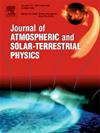Nighttime and seasonal variation of lower ionospheric parameters using tweek analysis during minimum solar activity period over low latitude
IF 1.9
4区 地球科学
Q3 GEOCHEMISTRY & GEOPHYSICS
Journal of Atmospheric and Solar-Terrestrial Physics
Pub Date : 2025-02-20
DOI:10.1016/j.jastp.2025.106476
引用次数: 0
Abstract
VLF signals are continuously recorded, monitored, and observed by an Automatic Whistler Detector (AWD) installed at our low latitude Indian station, Banaras Hindu University, Varanasi (geom. lat. 14° 55’ N, geom. long. 154° E and geog. lat. 25°15′ 20″ N, long. 82° 59’ 21” E). In the present study, the nighttime and seasonal variation of lower ionospheric parameters mainly D-region during a low solar minimum period from 2018 to 2019 has been analyzed at a low latitude station in Varanasi. Since large numbers of tweeks have been observed at Varanasi, we have randomly chosen three days in a month during the summer (June), winter (November), and equinox (September/October) seasons in the years, 2018 and 2019, where good-quality, continuous nighttime data were available. A total of 35,000 tweeks recorded up to n = 1–10 harmonics in different seasons: summer, winter, and equinox showed percentage occurrences of approximately 37%, 32%, and 31% in 2018 and 38%, 31%, and 31% in 2019 respectively during the solar minimum period of solar cycle 24. The analysis of tweeks with harmonics up to tenth modes in different seasons showed higher occurrence in summer, reflecting at less diverse altitudes than winter and equinox seasons, with propagation paths ranging from 500 to 8500 km in 2018 and 800–8000 km in 2019. Nighttime lower ionospheric daily average electron density (ne) values varied from 23 to 26 cm−3 at altitudes of 80–94 km during 2018 and 2019. The D-region is less uniform at higher altitudes during summer. The effect of reflection height on frequency, attenuation factor, time delay, and the usefulness of tweek method for estimating electron density in the nighttime D region ionosphere for different harmonics are also discussed in this study. The electron density (ne) values obtained by the tweek method during various seasons are compared to IRI-2016, radar data, and rocket data, all of which fall within a similar range of variations specifically between 80 and 90 km showing a better estimation by the tweek method. Further, we have also evaluated the attenuation coefficient of the nighttime tweek propagation. We have also simulated the frequency-time spectrum of different modes of tweeks at various heights and propagation paths.
利用tweek分析低纬度太阳活动最小期电离层下部参数的夜间和季节变化
VLF信号由安装在我们位于印度瓦拉纳西巴纳拉斯印度教大学的低纬度印度站的自动哨声探测器(AWD)连续记录、监测和观察。纬度。北纬14°55′,地球。长。东经154°和地质。纬度。25°15′20″N,长。本文分析了2018 - 2019年太阳活动极小期以d区为主的下电离层参数夜间和季节变化。由于在瓦拉纳西观测到大量的双周,我们在2018年和2019年的夏季(6月)、冬季(11月)和春分季节(9月/ 10月)随机选择了一个月中的三天,在这些季节可以获得高质量的连续夜间数据。在不同的季节,共有35000个星期记录到n = 1-10次谐波:夏季、冬季和春分,2018年和2019年的百分比分别约为37%、32%和31%,在第24太阳周期的太阳最小期分别为38%、31%和31%。不同季节次谐波至10次模态的双峰分析显示,夏季出现频率较高,海拔差异小于冬季和春分季节,2018年传播路径在500 ~ 8500 km之间,2019年传播路径在800 ~ 8000 km之间。2018年和2019年,在80-94公里高度,夜间较低电离层日平均电子密度(ne)值在23至26 cm−3之间变化。夏季,d区在高海拔地区不太均匀。本文还讨论了反射高度对频率、衰减因子、时延的影响,以及tweek方法在夜间D区电离层中对不同谐波的电子密度估计的有效性。通过tweek方法在不同季节获得的电子密度(ne)值与IRI-2016、雷达数据和火箭数据进行了比较,所有这些数据都在相似的变化范围内,特别是在80到90公里之间,表明tweek方法的估计效果更好。此外,我们还计算了夜间微波传播的衰减系数。我们还模拟了不同高度和不同传播路径下不同模式的频率时间谱。
本文章由计算机程序翻译,如有差异,请以英文原文为准。
求助全文
约1分钟内获得全文
求助全文
来源期刊

Journal of Atmospheric and Solar-Terrestrial Physics
地学-地球化学与地球物理
CiteScore
4.10
自引率
5.30%
发文量
95
审稿时长
6 months
期刊介绍:
The Journal of Atmospheric and Solar-Terrestrial Physics (JASTP) is an international journal concerned with the inter-disciplinary science of the Earth''s atmospheric and space environment, especially the highly varied and highly variable physical phenomena that occur in this natural laboratory and the processes that couple them.
The journal covers the physical processes operating in the troposphere, stratosphere, mesosphere, thermosphere, ionosphere, magnetosphere, the Sun, interplanetary medium, and heliosphere. Phenomena occurring in other "spheres", solar influences on climate, and supporting laboratory measurements are also considered. The journal deals especially with the coupling between the different regions.
Solar flares, coronal mass ejections, and other energetic events on the Sun create interesting and important perturbations in the near-Earth space environment. The physics of such "space weather" is central to the Journal of Atmospheric and Solar-Terrestrial Physics and the journal welcomes papers that lead in the direction of a predictive understanding of the coupled system. Regarding the upper atmosphere, the subjects of aeronomy, geomagnetism and geoelectricity, auroral phenomena, radio wave propagation, and plasma instabilities, are examples within the broad field of solar-terrestrial physics which emphasise the energy exchange between the solar wind, the magnetospheric and ionospheric plasmas, and the neutral gas. In the lower atmosphere, topics covered range from mesoscale to global scale dynamics, to atmospheric electricity, lightning and its effects, and to anthropogenic changes.
 求助内容:
求助内容: 应助结果提醒方式:
应助结果提醒方式:


